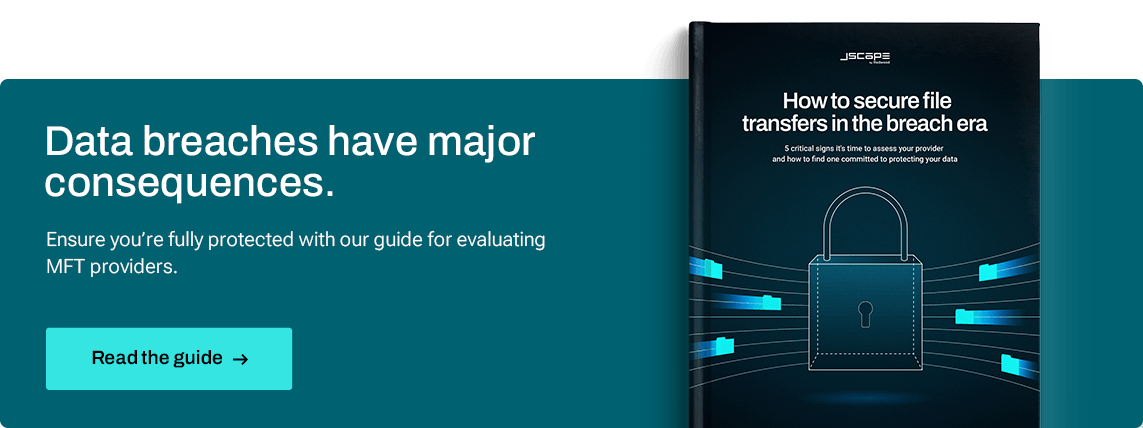13 methods for maintaining data security during file transfer

Data breaches can lead to devastating outcomes, including significant financial losses, damage to your reputation or even legal consequences. Maintaining a robust security posture can help you defend against threats while improving the efficiency and reliability of your processes.
But securing data isn’t about sealing it off from the outside world. In an interconnected business environment, data must flow freely across borders and between teams, vendors and platforms. With such openness comes the challenge of ensuring data transfers don’t compromise security.
In this article, we’ll explore 13 practical methods to safeguard your data during file transfers and share tips for finding the right data security solution for MFT.
The state of cybersecurity today
A wide range of threats can jeopardize the confidentiality, integrity and availability of your data. These threats can be external, such as cyberattacks like malware, phishing and DDoS, or internal, where human error or malicious insiders can expose critical information.
Third parties and internal threats are equally concerning. Understanding and being prepared to handle both is the best way to prepare for an attack by a bad actor. A comprehensive enterprise security strategy protects digital assets regardless of the source of a threat.
13 effective data security strategies
Use the following methods and tools to build a strong security framework and enhance your data protection across various platforms.
1. Multi-factor authentication (MFA)
Unauthorized access presents a major risk. By requiring users to provide multiple forms of verification (not just a username and password), you can consistently confirm their identities and rest assured that the people gaining access to your sensitive data are allowed to do so.
MFA requires providing two or more credentials, including a password, biometric data like a fingerprint, a security token or a code sent to the user’s phone. For example, a managed file transfer (MFT) solution might require a password plus a fingerprint scan to log in. Not only is this best practice, but it reinforces a culture of security awareness within your organization.
2. File encryption and virtual paths
Encryption converts data into unreadable code, preventing unauthorized access even if your data is intercepted. An extra layer of defense is to require a decryption key for accessibility after compromise. The most secure MFT solutions can feature triggers that automatically encrypt data upon upload or by securing entire virtual paths.
Triggers are a targeted encryption approach that enables selective data security measures based on predefined criteria such as filename and file type. Virtual paths in a file system enable you to map user access to specific physical paths within your domain, streamlining user management and permission settings and allowing for centralized control without needing to manage permissions at the operating system level.
3. Role-based access management
Granular access controls give your employees access to only the data that’s necessary for their roles. Reviewing and updating access permissions on a regular basis minimizes the risk of privilege escalation — when users gain unauthorized access to sensitive information over time.
Role-based management allows you to define specific permissions, such as restricting access to certain domains or limiting the visibility of user data. You could create a role that permits an administrator to manage triggers only within a specified domain or restrict their visibility to users in a specific location.
4. Real-time threat detection
Intrusion Detection Systems (IDS) monitor and respond to threats in real time. With notifications and alerts, stakeholders in any file exchange can stay informed about suspicious activity and be prepared for immediate action.
Incorporating AI-driven threat detection can further enhance your ability to identify and respond to emerging threats that could bypass traditional security measures.
5. Frequent security audits
Regular security audits are vital for identifying vulnerabilities in your systems and ensuring compliance with industry standards. They help you maintain a strong security posture by highlighting areas for improvement and enforcing consistent security practices.
Surprise audits can be particularly effective in revealing weaknesses that may not be evident during scheduled assessments.
6. Data loss prevention (DLP)
DLP strategies are designed to identify and protect sensitive information. With DLP rules, you can prevent the unauthorized distribution of critical data like credit card or personal identification numbers (PINs). Implementing it across all communication channels, including email and cloud services, gives you comprehensive protection.
Integrating a DLP processor into your MFT server (or using a solution with a built-in processor) can help you enforce data protection policies and reduce the risk of data leaks.
7. Advanced network security
Advanced firewalls play a crucial role in defending your network by enforcing security policies between internal systems and external networks. Integrating analytics tools with your firewall solutions can help you prevent sophisticated attacks.
Network segmentation, combined with continuous monitoring, prevents unauthorized access and isolates sensitive data to minimize the impact of a potential breach.
8. Secure cloud environments
In SaaS architectures, customer environments should be isolated within dedicated zones. You should secure access using HTTPS/TLS. Regular updates and patches to your cloud security protocols can help you keep up with evolving threats.
MFT platforms that leverage cloud providers like Amazon Web Services (AWS) add additional security layers to ensure your data transfers are protected in compliance with best practices and regulatory standards, such as HIPAA and PCI DSS.
9. Third-party risk management
Effective risk management requires a thorough assessment of third-party vendors and supply chains. Regular audits and strict security protocols can give you reassurance that third-party services meet your organization’s security standards. Collaborating with your third-party vendors can present opportunities to align security practices.
Conduct regular security audits of vendors. You may choose to only offer access to your environment using a firewall or via DMZ streaming.
10. Data backup and disaster recovery
Robust data backup and disaster recovery procedures maintain data integrity and business continuity.
One of the best tools for this is a failover server, which assumes the responsibilities of a production server if it becomes unavailable. Most file transfer solutions don’t have built-in failover and require integration with supplemental data security solutions.
See why its failover mechanisms make JSCAPE by Redwood stand out in the MFT space.
11. Automated trigger management
Managing triggers related to file transfers is essential to prevent unintended data transfers.
By setting up event-based triggers to execute only upon actions by a particular user, time frame, event type and more, you can prevent file transfer automation from inadvertently moving malicious data into your organization.
12. Policy enforcement
Developing and enforcing comprehensive privacy policies will help your organization comply with data protection laws and regulations. Because security best practices are constantly evolving, it’s important to choose an MFT provider that continuously updates its solutions and stays ahead of evolving security challenges.
Embed privacy by design into your policies to ensure that data protection is a priority at every stage of your operations.
13. Security posture assessments
Regular security posture assessments are non-negotiable. Your IT experts not only need to protect your organization; they also should understand your level of risk of becoming a victim of a breach or attack.
How to complete a security posture assessment
- Inventory IT assets. Catalog all hardware, software and cloud resources to understand your complete attack surface.
- Map the attack surface. Analyze and identify vulnerabilities, misconfigurations and potential cyber threat entry points to pinpoint your areas of weakness.
- Assess cyber risk and resilience. Evaluate the likelihood and impact of potential attacks and assess your readiness to detect, respond and recover from security incidents.
- Prioritize and remediate vulnerabilities. Leverage insights from the risk assessment to prioritize and fix the most critical vulnerabilities.
- Continuously monitor and improve. Stay vigilant with continuous monitoring to adapt to new threats.
- Respond to incidents quickly. Develop and maintain an incident response plan that includes procedures for containment, investigation and recovery.
Third-party assessments can also be helpful in giving you an unbiased view of your security posture.
Selecting the right data security solutions for file transfer
Because your organization handles a unique set of data and may face industry-specific regulatory requirements, you’ll want to carefully evaluate MFT providers, platforms with integrated MFT and supporting data security solutions.
Use these six key steps in the vetting process.
- Understand your data: Begin by taking inventory of the types of data your enterprise manages. Are you transferring financial data, personal data, intellectual property or other forms of sensitive data? The classification will help you identify the level and type of protection you require.
- Evaluate regulatory compliance: Adhering to regulations, such as SOX for financial reporting and GDPR for data protection in the European Union, is essential. Your choice of data security solutions should support and simplify the compliance process, ensuring you meet privacy regulations.
- Consider scalability: As your business expands, your security requirements will also increase. Choose scalable solutions to handle growing data volumes and adapt to evolving security threats across all your operational environments.
- Assess existing infrastructure: Carefully evaluate your current IT environment to ensure compatibility with your existing infrastructure. Thoroughly review endpoints, data centers and multi-cloud setups to guarantee that security tools integrate smoothly across all platforms.
- Establish budget constraints: Be realistic about what you can afford, but also recognize that skimping on data security can lead to the most costly breaches or velocity-reducing tech debt. Many companies find out the hard way that investing in advanced threat detection systems and secure data platforms is worth it.
- Research potential providers’ reputations: Look for strong customer service, quality technical support and a clear roadmap for features and innovation.
5 signs of a first-rate security vendor
When evaluating security vendors with MFT in mind, look for key indicators that demonstrate their reliability and effectiveness in safeguarding data.
A proven track record
The most reliable providers have a solid history in the industry, particularly in areas such as encryption key management, DLP and Identity and Access Management (IAM) systems. Those with industry certifications and plentiful customer testimonials can prove their commitment to high security standards.
Flexibility
Select security solutions that enable you to tailor protocols: the ability to modify access controls, encrypt data and enforce policies to align precisely with your security requirements. A wide range of connectors and API-driven integration options can also ensure compatibility and scalability with your future tech stack.
Layered defense strategies
Opt for solutions that provide a layered approach to security to reduce the likelihood of a single point of failure. Combining several tactics, such as firewalls, access management and multi-factor authentication, can generate a more robust defense. Integrated solutions also help create a resilient security posture against various cyberattacks, including malware, ransomware and phishing.
User-friendliness
User-friendly interfaces and features such as low-code automation can significantly reduce the chance of human error. Solutions with minimal training time and educational resources for new users can help you drive widespread adoption and, therefore, consistency.
Zero-trust architecture
Unlike traditional “defense-in-depth” approaches that operate under a trust model, zero-trust architecture (ZTA) operates under the assumption that all network traffic is potentially hostile. Designed to incorporate security deeply within a network’s DNA, adhering to principles that require secure access for all resources, strict access controls based on necessity, verification over trust, thorough inspection of all incoming log traffic for malicious activity and network design that starts from the inside out.

Opt for workload automation with integrated MFT
Maintaining a secure and resilient digital environment means choosing software providers that can support you in implementing the above 13 methods. Selecting a vendor that offers integrated workload automation and MFT capabilities gives you full visibility into data transfers and aligns them with your broader operational goals.
Find out how the power combination of RunMyJobs by Redwood and JSCAPE by Redwood can drive efficient, automated and secure processes across your entire enterprise — for file transfers and beyond.
Book a demo to see how JSCAPE’s security features can expand the vast workload automation features of RunMyJobs and strengthen the defenses of your IT infrastructure.
About The Author

Andy Sharma
Andy Sharma is a seasoned global IT and business executive with deep expertise in information security, digital transformation and cloud initiatives across multiple industries. With a proven track record in delivering financial benefits, building high-performance teams and leading successful M&A activities, he has held pivotal leadership roles, including CIO & CISO at Redwood Software and Optiva and Technology COO at Santander Consumer USA.
As both a CIO and CISO, Andy has implemented robust cybersecurity measures, ensured regulatory compliance and mitigated risks across global organizations, consistently bridging technology and business to drive growth and operational excellence.